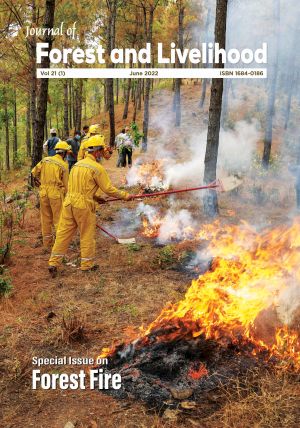Temporal and Spatial Distribution of Forest Fires and their Environmental and Socio-economic Implications in Nepal
DOI:
https://doi.org/10.3126/jfl.v21i1.56575Keywords:
Fire drivers, fire occurrence, fire risk, forest fuel, MODIS active fireAbstract
Forest fire is a global phenomenon, resulting in devastation across regions. Nepal is not an exception where forest ecosystems and environment are vulnerable to forest fires, causing loss of properties and lives. While a range of studies have been conducted on the causes of forest fire and its impact, temporal and spatial dimensions along with ecological and socio-economic implications are largely overlooked. This paper aims to identify the temporal and spatial distribution of forest fire, and its implications on forest ecology, environmental, and socio-economic sectors of Nepal. Data on fire incidences and burnt areas were obtained from the Moderate Resolution Imaging Spectroradiometer (MODIS) and information pertaining to environmental and socio-economic implications were collected from various secondary sources. The 2001-2020 data revealed increasing forest fire incidences. Seasonally, pre-monsoon appeared to have higher frequencies of forest fires. By province, the Tarai and Siwalik regions of the Sudurpaschim Province, Madhesh Province, Lumbini Province, and Bagmati Province are susceptible to fire. In terms of fire risk, the Tarai-Siwalik region of Sudurpaschim and Madhesh Province are at very high forest fire risk. In terms of environmental loss and damage, every year on an average, 3,098 fire incidences occur resulting in damage to 172,040.65 hectares (ha) of forest and biomass loss of 7.07 million tons per year accounting to emission of 3.30 million tons of carbon per year. During 2020-2021 period, a total of Nepalese Rupees (NPR) 1890000 (USD 15240.70) was lost due to the damage incurred by forest fire. Likewise, from 2007 to 2021, 71 human casualties have been recorded. Both natural and anthropogenic factors are responsible for the occurrence of forest fire in Nepal. Thus, for the protection of forests, properties and lives, strict forest fire mitigation policies and practices ensuring sustainable forest fire management is crucial.
Downloads
Downloads
Published
How to Cite
Issue
Section
License

This work is licensed under a Creative Commons Attribution-NonCommercial 4.0 International License.
CC-BY-NC: This license allows reusers to distribute, remix, adapt, and build upon the material in any medium or format for noncommercial purposes only, and only so long as attribution is given to the creator.





